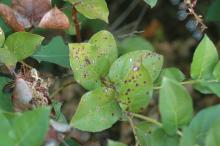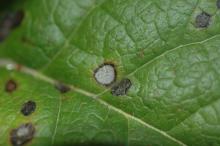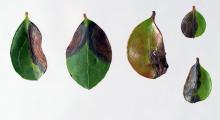See:
Tanoak (Notholithocarpus densiflorus) - Sudden Oak Death
Cause Many fungi are reported including Dasyschypha sp., Phyllosticta pyrolae, and Pestalopezia sp. The OSU Plant Clinic has identified Phyllosticta sp. most often. Phyllosticta pyrolae and P. vaccinii (as well as many other fungi) were most frequently isolated from healthy leaves collected from western Oregon. Elsinoe ledi will cause a disease called spot anthracnose.
A survey of the fungi associated with severe leaf spots on salal growing on southern Vancouver Island, BC found Alternaria sp., Monochaetia sp., Pestalotiopsis spp., Phoma sp., Phomopsis sp., Phyllosticta pyrolae, and Valdensia heterodoxa (formerly Valdensinia heterodoxa) as the most common.
Phytophthora ramorum (Sudden Oak Death) can also produce necrotic leaf spots and petiole lesions on salal and other Gaultheria sp. (such as G. procumbens). This is a quarantined pest so if you suspect you have seen a P. ramorum-infected plant in Oregon, call the Invasive Species Hotline, 1-866-INVADER (1-866-468-2337).
Most fungal leaf spots are favored by wet weather that keeps leaves wet for extended periods of time. They generally survive unfavorable conditions in plant debris.
Symptoms Phyllosticta leaf spots are nearly circular and brown with pale centers. Spots may start as a small water-soaked or pinhead-size spot. Generally, spots are only a few millimeters wide in nature but can enlarge and coalesce in cold storage. Small, black, fruiting bodies (pycnidia) develop in the spots' centers. Can also produce a stem lesion.
Spot anthracnose is grayish white with a red-brown border and purple margin.
Valdensinia leaf spot - A brown, necrotic leaf spot with concentric rings. Mature infections are characterized by sclerotia on the host veins, followed by leaf death and defoliation.
Symptoms of Ramorum leaf blight occur where water collects, such as the tips or margins of the leaf. Infected foliage initially appeared water-soaked, gradually turning brown or black as the tissue was killed and dried out. Lesions were visible on both upper and lower surfaces of the leaves and bounded by leaf veins. The lesions were light tan in color on younger foliage and dark brown to black on mature foliage.
Cultural control
- Remove infected, dead, and dying leaves on and near plants.
- Avoid overhead irrigation or apply such that plants are not wet for extended periods of time.
Chemical control Fixed coppers may be useful, but no copper-based chemicals are labeled specifically for this crop.
- Abound at 6 to 15.5 fl oz/A. Do not apply with silicone-based surfactants. May be applied on the day of harvest. Group 11 fungicide. 4-hr reentry.
- Fontelis at 16 to 24 fl oz/A. Can be used day of harvest. Group 7 fungicide. 12-hr reentry.
- Inspire Super at 16 to 20 fl oz/A. Do not apply within 7 days of harvest. Group 3 + 9 fungicide. 12-hr reentry.
- Miravis Prime at 9 to 13.4 fl oz/A. May be used day of harvest. Group 7 + 12 fungicide. 12-hr reentry.
- Proline 480 SC at 5.7 fl oz/A. Do not use within 7 days of harvest. Group 3 fungicide. 12-hr reentry.
- Omega 500 F at 20 fl oz/A. Do not use within 30 days of harvest. Group 29 fungicide. 12-hr reentry.
- Quadris at 6 to 15.5 fl oz/A. Do not apply with silicone-based surfactants. May be applied on the day of harvest. Group 11 fungicide. 4-hr reentry.
- Quash at 2.5 oz/A. Do not use within 7 days of harvest. Group 3 fungicide. 12-hr reentry.
- Tilt at 6 fl oz/A. Do not use within 30 days of harvest. Group 3 fungicide. 24-hr reentry.
References Elliott, M., Rollins, L., Bourret, T., Hulbert, J. M. and Chastagner, G. 2021. Three new hosts for Phytophthora ramorum confirmed in Washington State: Salal, Oregon grape, and red huckleberry. Plant Health Progress, https://doi.org/10.1094/PHP-01-21-0003-FI.
Petrini, O., Stone, J., and Carroll, F.E. 1982. Endophytic fungi in evergreen shrubs in western Oregon: a preliminary study. Canadian Journal of Botany, 60:789-796.
Shamoun, S.F., Countess, R.E., and Vogelgsang, S. 2000. The mycobiota of salal (Gaultheria shallon) collected on Vancouver Island and the exploitation of fungal pathogens for biological control. Canadian Journal of Plant Pathology 22:192.





